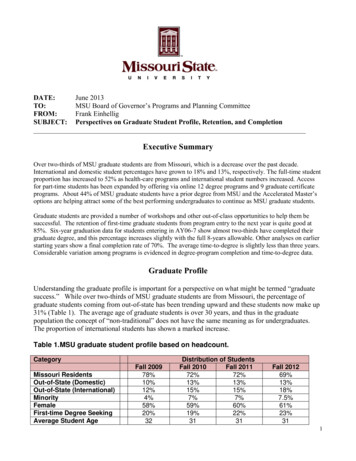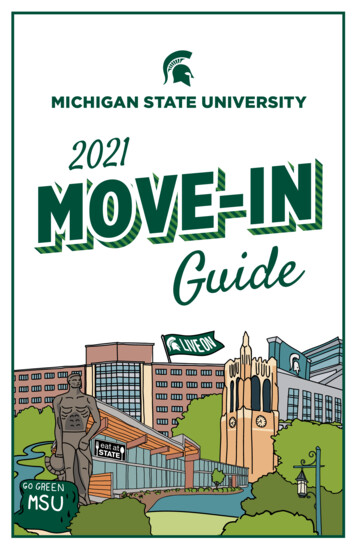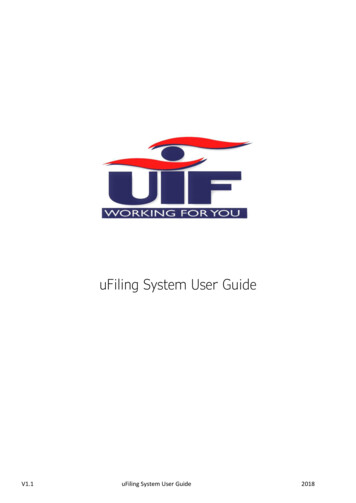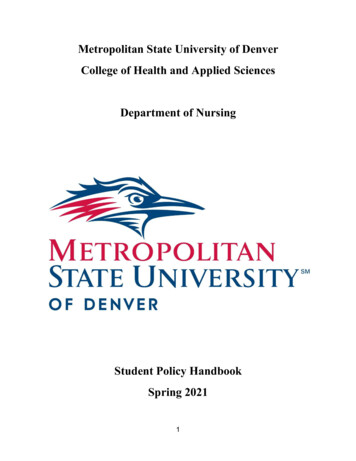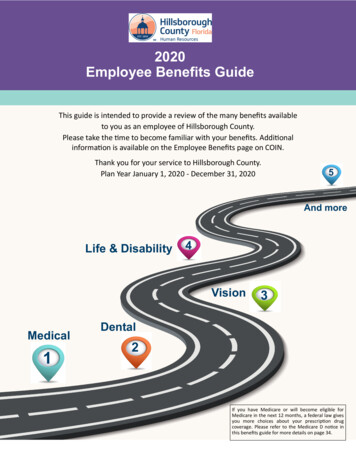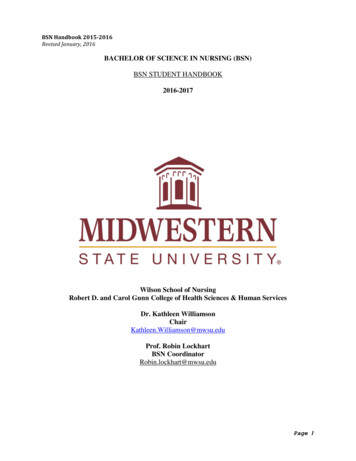
Transcription
2020 MSU BenefitsOffice of Human Resources301 Howell McDowellMorehead, KY 40351Phone: 606-783-2097Fax: 606-783-5028benefits@moreheadstate.edu
Table of ContentsEnrollment Eligibility . 2Health Care Terminology. 4Your Medical Plan Options . 5Surcharges . 8Prescription Medications . 10Health Savings Account . 12The Rewards of Wellness. 16Voluntary Dental Benefits . 21Flexible Spending Accounts (FSAs) . 24Your Life Insurance Benefits . 28Retirement Options . 30Sick Leave Bank. 32Other Benefits . 33MASA Ambulance Transport Services. 35Get the App . 36This benefits guide contains only highlights of the major provisions of the benefits program at MoreheadState University. Legal documents describe the plans in complete detail and govern their operation. If thereis any disagreement between this guide and any legal document, the terms of the legal document alwaysgovern. Morehead State University reserves the right to change, suspend, or end benefits plans at any time.1
Enrollment EligibilityRegular full-time employees are eligible to enroll themselves and their eligible family members in MSU’sbenefits. Eligible family members include your: SpouseChildren up to age 26 (see our plan document for more information about dependent eligibility)“Sponsored dependents” as defined belowWhen you enroll eligible family members, you must provide their Social Security number, birthdate,address, and relationship to you. This information is required; they will not be covered unless youprovide it to MSU.Also note, when you elect a medical or dental plan, you can choose which eligible family members you wantto cover under each plan. The family members you cover under each plan do not have to be the same. Forexample, you can cover yourself and your dependents for medical, but choose to cover yourself only underthe dental plan.Covering a “Sponsored Dependent”Employees may enroll a “sponsored dependent” and his/her eligible children in MSU coverage, providedthey meet the following criteria:A sponsored dependent is defined as an adult that shares primary residence with a coveredemployee. The sponsored dependent must: Have lived with the MSU employee for at least 12 months prior to the effective date of coverage;Be at least the age of majority;Not be a relative (see definition of relative below); andNot be employed by MSU.A sponsored dependent’s children are defined as those who: Share primary residence with the covered MSU employee;Are under age 26;Are the natural born or adopted child of the sponsored dependent; andAre not relatives of the covered MSU employee. (Relatives include parents, children, spouses,brothers, sisters, brothers- and sisters-in law, mothers- and fathers-in law, uncles, aunts, cousins,nieces, great nieces, nephews, great nephews, grandmothers, grandfathers, great grandmothers,great grandfathers, sons- and daughters-in law and half- or step-relatives of the same relationships.Note: Children for whom the employee has legal guardianship are eligible as the employee’sdependents.)To add a sponsored dependent and his/her children to your coverage, an Affidavit of SponsoredDependent Relationship must be signed by both adult parties and notarized. Additionally, proof ofcommon residency for a 12-month period must be provided. This could include a driver’s license with thesame address issued for 12 months, rental agreement or mortgage, utility bills in names with a commonaddress that are more than one-year old. The employee must also complete an Anthem Affidavit.2
Health Insurance Premiums and IRS Tax Regulations Related to SponsoredDependentsIn accordance with IRS regulations: The portion of insurance premiums for the sponsored dependent and his/her dependent childrenmust be paid on a post-tax basis. Medical expenses incurred by the sponsored dependent and his/her dependent children are notallowed for reimbursement under the employee’s flexible health care spending account (IRC Section125) or Health Reimbursement Arrangement (HRA). The sponsored dependent is not eligible for wellness incentives.The portion of insurance premiums paid by the employee for the sponsored dependent and his/hersponsored dependent children is not subsidized by the University. The employee will receive a single MSUcontribution only. Also, MSU’s contribution to the Health Savings Account or Health ReimbursementArrangement will be at the single level.When Changes Are AllowedChanges to your benefits (medical, dental, life insurance, and flexible spending accounts) during the planyear are permitted only if you have a life event change that affects your benefits coverage. Followingexamples of life event changes: You get married, separated, or divorcedYou have a baby or adopt a childYou or your spouse starts or ends employmentA dependent starts or stops being eligibleYour spouse’s health care coverage through his or her employer changesYou must sign a change form and submit it to the Office of Human Resources and Payroll within 30 days ofyour change in status. You will need to provide proof of your qualifying event, such as a copy of a marriagelicense, divorce decree, birth/adoption certificate, or a letter from your spouse’s employer.3
Healthcare Terminology Glossary Coinsurance: A percentage of a health care cost—such as 20 percent—that the covered employeepays after meeting the deductible. Copayment: The fixed dollar amount—such as 30 for each doctor visit—that the coveredemployee pays for medical services. Deductible: A fixed dollar amount that the covered employee must pay out of pocket eachcalendar year before the plan will begin reimbursing for expenses. Plans usually require separatelimits per person and per family. Formulary: A list of prescription drugs covered by the health plan, often structured in tiers thatsubsidize low‐cost generics at a higher percentage than higher‐cost brand‐name drugs. Health savings account (HSA): HSAs may be opened by employees who enroll in a high‐ deductiblehealth plan. Employees can put money in an HSA up to an annual limit set by the government (for2019, the limit is 3,500 for self‐only coverage and 7,000 for family coverage), using pre‐tax dollars.Employers may also contribute funds to these accounts within the prescribed limit. HSA funds may beused to pay for medical expenses whether or not the deductible has been met, and no tax is owed onfunds withdrawn from an HSA to pay for medical expenses. HSAs are individually owned and theaccount remains with an employee after employment ends. High‐deductible health plan (HDHP): An HDHP features higher annual deductibles thantraditional health plans, such as a preferred provider organization (PPO) plan. With the exception ofpreventive care, employees must meet the annual deductible before the plan pays benefits. HDHPs,however, may have significantly lower premiums than a PPO or other traditional plan. Preferred Provider Plan (PPO): A type of health plan that contracts with medical providers, such ashospitals and doctors, to create a network of participating providers. Your out‐of‐pocket cost is lower ifyou use providers that belong to the plan's network. In‐network: Doctors, clinics, hospitals and other providers with whom the health plan has anagreement to care for its members. Health plans cover a greater share of the cost for in‐networkhealth providers than for providers who are out‐of‐network. Out‐of‐network: A health plan will cover treatment for doctors, clinics, hospitals and otherproviders who are out‐of‐network, but covered employees will pay more out‐of‐pocket to use out‐of‐network providers than for in‐network providers. Out‐of‐pocket limit: The most an employee could pay during a coverage period (usually oneyear) for his/her share of the costs of covered services, including co‐payments & co‐insurance. Premium: The amount that must be paid for a health insurance plan by covered employees, bytheir employer, or shared by both. A covered employee’s share of the premium is generally paidperiodically, such as monthly, and deducted from his or her paycheck. Flexible Spending Accounts—Health or Dependent Care (HCFSA or DCFSA): An account youput money into that you use to pay for certain out‐of‐pocket health or childcare costs. You don't paytaxes on this money. This means you'll save an amount equal to the taxes you would have paid onthe money you set aside. You lose this money each year if it is not used on qualified expenses.4
Your Medical Plan OptionsMSU offers you a choice of three medical plans: The Life Long Savings PlanThe Enhanced HRA Value PlanThe PPO PlanEach plan covers in-network preventive care at no cost to you. The plans use the same network of Anthemproviders. And, each plan requires you to meet an annual deductible. The following table highlights keyfeatures in the plans.Lowest PayrollDeductionsEnhanced HRAValue PlanHigher MSUContributions to HealthReimbursementArrangement (HRA) thanwith PPO PlanLower PayrollDeductions than PPOIncludes a HealthReimbursementArrangement (HRA) andoffers the lowest MSUcontributionHighest PayrollDeductions 2,800 1,500 1,650After deductible, you pay10% coinsurance forin-network services andprescription drugsAfter deductible, you pay15% coinsurance forin-network services andprescription drugsThere are no copaysunder this planThere are no copaysunder this planYou pay set copays forsome in-networkservices and prescriptiondrugs 4,600 4,000 3,500Plan FeatureLife Long Savings PlanMSUContribution toAnnual AccountIncludes a HealthSavings Account (HSA),and offers the highestMSU ost SharingIndividualOut-of-pocketMax (in-network)PPO PlanAfter deductible, you pay20% coinsurance forin-network servicessubject to coinsurance.Reminder: Key Plan Terms Deductible: This is the amount of your own money that you pay for health care services andprescription drugs, before the plan pays its share of the costs. Remember, you can use your MSUprovided HSA or HRA dollars to meet your deductible.Coinsurance: Once you meet the deductible, you and MSU share the costs for services until you reachthe out-of-pocket maximum.Copays: Some services under the PPO Plan require copayments. This is a set amount you pay forhealth care services and prescription drugs at the time you receive your care. Services that require acopay are not subject to the PPO deductible, nor do your copays count toward meeting the deductible.Out-of-pocket Maximum: Consider this your “safety net.” This is the most you pay out of your ownwallet for health care services in a calendar year.5
Compare the Medical PlansMaximum MSU Annual Account Contributions—Use these MSU-provided funds to pay yourshare of covered health care expensesLife Long Savings PlanCoverage LevelHSASingleEmployee SpouseEmployee Child(ren)Family 400 800 1,200 1,200WellnessIncentive 675 1,350 675 1,350Enhanced HRAValue PlanTotalHRA 1,075 2,150 1,875 2,550 200 400 600 600WellnessIncentive 675 1,350 675 1,350PPO PlanTotalHRA 875 1,750 1,275 1,950 100 200 300 300WellnessIncentive 675 1,350 675 1,350Total 775 1,550 975 1,650Monthly Payroll Deductions—Cost is based on the plan and coverage level you select, andwhether you are tobacco-freeEMPLOYEE MONTHLY PREMIUMSLife LongSavingsPlanCoverage LevelEnhancedHRAValuePlanPPO PlanTobaccoUserSurchargeADDSingle 92 125 168 200Employee Spouse 265 313 372 200Employee Child(ren) 231 249 312 200FamilyEmployee Spouse Cross Reference(Both Spouses Employed at MSU)Family Cross Reference(Both Spouses Employed at MSU)Sponsored Dependent – Employee Partner 325 374 451 - 13 86 184 250 336 508 573 640Sponsored Dependent – Family 728 810 890SpousalSurchargeADD 150200 150 200 150 200 150 200 150 200 150Cost Sharing ProvisionsLife Long Savings PlanIn-NetworkDeductibleIndividualFamilyEmployee CoinsuranceCopaysOut-of-pocket MaxIndividualFamilyNon-Network 2,800 5,400 5,400 10,800You pay 10% You pay 50%Do not apply 4,600 9,200 9,200 18,400Enhanced HRAValue PlanIn-NetworkNon-Network 1,500 3,000 3,000 6,000You pay 15% You pay 50%Do not apply 4,000 8,000 8,000 16,000PPO PlanIn-NetworkNon-Network 1,650 3,500 3,300 7,000You pay 20% You pay 50%Apply for some services 3,500 7,000 8,500 17,0006
How Cost Sharing Applies When You Need CareLife Long Savings PlanIn-NetworkPreventive CareFreePhysician Office ServicesTelemedicineMinute ClinicSpecialist Office ServicesUrgent Care ServicesEmergency RoomServicesInpatient HospitalOutpatient ServicesPrescription DrugsNon-NetworkCoinsuranceapplies afterdeductibleCoinsurance applies afterdeductibleEnhanced HRAValue PlanIn-NetworkFreeNon-NetworkCoinsuranceapplies afterdeductibleCoinsurance applies afterdeductiblePPO PlanIn-NetworkNon-NetworkFreeCoinsurance 35 copayapplies after 35 copaydeductible 35 copay 50 copay 70 copay 150 copay plus 20%coinsurance after deductibleCoinsurance applies afterdeductibleRx deductible (applies forTier 1, 2 and 3 drugs): 50Single; 100 2-Person andFamilyTier 1 copay: 10 retail; 25mail orderCoverage combined withmedicalCoverage combined withmedicalTier 2 copay: 30 retail; 75mail orderTier 3 copay: 60 retail; 150mail orderTier 4: You pay 25%coinsuranceYou pay less of your own money when you visit network providers. Find an in-networkprovider at www.anthem.com. Look for Anthem’s Blue Distinction providers!7
Tobacco User Surcharge“Tobacco” includes any form of tobacco products that are smoked (e.g., cigarettes, cigars, pipes); applied tothe gums, chewed, or ingested (e.g., dipping or chewing leaf tobacco); and/or inhaled (e.g., snuff orelectronic cigarettes). The tobacco user surcharge applies if you or your covered spouse use any productslisted above.New EmployeesNew employees and spouses covered under MSU’s health insurance plan must complete a negativeCotinine test (saliva test). Cotinine testing is available in Counseling and Health Services (CHS); however,you will be responsible for any charge assessed by CHS. You can schedule an appointment for your salivatest by calling 783-2055.SMOKING CESSATION PROGRAMMorehead State University promotes and supports healthy lifestyles for our employees and families throughboth our benefits and wellness programs. Quitting tobacco is difficult, so MSU is providing a resource, freeof charge, for employees and spouses to become tobacco free.Freedom From Smoking , America’s gold standard smoking cessation program for over 25 years, is a stepby-step, 7 week/8 session program where you will gain the skills and techniques needed to controlbehaviors leading to tobacco use. The Freedom From Smoking program has helped hundreds ofthousands of people quit smoking - and it can help you too!Waiver of Tobacco SurchargeIf you and/or your covered spouse enroll in and complete the Freedom From Smoking program, yourtobacco surcharge will be waived for the remainder of the plan year upon certification of completion by theprogram Facilitator. During the course of the cessation program, you will pay the tobacco surcharge;however, if you successfully complete the program, the surcharge paid while participating in the programwill be reimbursed. Program completion means that you attend all 8 sessions. Remote technology isavailable if you are traveling and other accommodations may be provided by the Facilitator.Spousal SurchargeIf your spouse or adult sponsored dependent covered under your MSU medical plan, you will beasked to confirm if he/she has access to medical coverage through his/her own employer or through aretirement plan by signing an Affidavit of Spousal Surcharge Compliance. If your spouse does haveaccess to other coverage, and you elect to enroll him/her on your MSU medical plan, a surcharge of 150per month will be added to your medical plan payroll deduction.If, at any point, your spouse ceases to be eligible for his/her medical coverage, he/she may be enrolledin your MSU medical plan. You will have 31 days from the loss of eligibility to enroll your spouse inMSU’s plan.An open enrollment under another employer’s benefit plan is considered a mid-year change in status(qualifying) event under Section 125. If your spouse’s open enrollment occurred earlier in the year and8
your spouse chose not to enroll in coverage for which he/she was eligible, he/she should contact his/heremployer and request to enroll in their employer’s benefit plan.This surcharge does not apply toward dependent children. You are still able to enroll your dependentchildren in the MSU medical plan regardless of your spouse’s status under this restriction.This surcharge does not apply to a spouse when both spouses are employed at MSU and covered undera MSU Spouse plan.Please complete the affidavit and return it to Human Resources: 301 Howell McDowell Fax: 3-9168 Email: benefits@moreheadstate.eduIf you do not return the Affidavit and you are enrolling or continuing to cover a spouse on aMSU medical plan, the surcharge will be imposed. You may not make any changes to yourelection until the following annual benefit enrollment period unless you experience a qualifyingevent.The Affidavit of Spousal Surcharge can be found at www.Moreheadstate.edu/hr. Please print and complete this affidavit andreturn it to Human Resources 301 Howell McDowell Fax: 3‐9168 Email: benefits@moreheadstate.edu9
Prescription MedicationsKnow Your Rx CoalitionMorehead State University is a member of the Know Your Rx Coalition, which is a purchasing coalition tohelp reduce costs. Through the coalition, we join other state and regional universities who are alsointerested in reducing costs while increasing the level of service to employees.Members enrolled in Morehead State University’s medical plans are automatically covered under theprescription drug plan and will have access to the services provided by Know Your Rx, which include: Free counseling service via live pharmacistsIdentification of lower cost prescription alternativesContacting physician to facilitate seeking authorization for lower cost alternative therapiesLiaison for patients/physicians for issues with Rx benefit including prior authorization, step therapy,and other programsEducational resources – adverse effects, drug interactions and general medication informationThe prescription drug program features: Convenient mail order program to help you save money on maintenance prescriptionsEasy-to-use retail pharmacy program with a broad network of Express Script pharmacies includingmajor pharmacy chains and independent storesRegardless of which medical plan you are enrolled in, you will have the opportunity to use a home deliverypharmacy service. If you are on the PPO plan, this program provides a 90-day supply of your maintenancemedication shipped to your home. Not only will you have the convenience of skipping the drug store, youwill receive three months of your medication.Know Your Rx Coalition855-218-5979www.kyrx.orgMONDAY-FRIDAY 8AM –6 PM E.T.KYRx@uky.edu10
Copayment Assistance for Certain Specialty DrugsThe copayments for certain specialty prescription drugs used to treat hepatitis C, cancer, or hereditaryangioedema will increase. However, MSU will offer employees the opportunity to enroll in a copayassistance program—offered in partnership with the drugs’ manufacturers—called the “Variable CopayProgram.” This program pays the significant share of the cost for these specialty drugs.If you are taking specialty drugs for the conditions noted above, you will receive a letter from Accredo(Express Scripts specialty pharmacy) alerting you to your new copayment and providing you withinstructions for enrolling in copay assistance for yourdrug. It only takes a few minutes to enroll.If you’re taking specialty medications forhepatitis C, cancer, or hereditary angioedema,When you enroll in this program, only the amount youwe encourage you to attend an open enrollmentpay out of your own pocket will count toward yourmeeting. The Variable Copay Program is on theannual deductible and out-of-pocket maximum. Theagenda.assistance you receive through the program will not beapplied.You can also contact the Office of HumanResources at 783-2097 to ask questions aboutyour personal situation.11
About the Health Savings Account (HSA)A Health Savings Account, or HSA, is a special bank account owned by you to pay for current and futurehealth care expenses. An HSA comes with the Life Long Savings Plan option, and when you choose thisplan, the university will establish an HSA for you with HealthEquity, our HSA plan custodian.How Your HSA is FundedMSU gets you started with a pre-tax “auto-contribution” to your HSA. The contribution amount is basedon the coverage level you choose:SingleEmployee SpouseEmployee Child(ren)FamilyMSU Automatic HSA ContributionLife Long Savings Plan 400 800 1,200 1,200MSU’s contribution is made in two installments: half on January 1, 2019 and half on July 1, 2019. You canuse the university’s contributions as soon as they are credited to your account.MSU contributes additional pre-tax money to your HSA when you participate in the Live Well, Work Well@ MSU program. When you complete all of the required activities, you receive up to:SingleEmployee SpouseEmployee Child(ren)FamilyLive Well, Work Well @ MSUHSA ContributionLife Long Savings Plan 675 1,350 675 1,350These HSA contributions are credited to your account as follows: Monthly for completing the online Personal Health Assessment and recording a preventive careexam by your Personal Health Care Provider. In July and December 2019, based on the Outcomes you meet and WellPoints you accumulatethrough the year.12
Finally, you can contribute your own money, tax-free, to your HSA. The IRS allows a total annualcontribution (MSU’s plus your own) of: 3,500 if you have Single coverage 7,000 if you have 2-Person or Family coverageAn additional “catch-up” contribution of 1,000 during2019 for age 55For example, if you are age 35 with Single coverage,assuming you get the maximum wellness incentive, you cancontribute up to 2,425 in 2019:( 3,500 - 400 - 675 2,425).You will decide how much of your own money (up to IRS limits)to contribute during open enrollment. However, you can adjustyour contribution amount at any time during the year. Yourcontributions will be made each pay period throughsemimonthly payroll deductions.PLAN YOUR HSACONTRIBUTIONS CAREFULLYIf you over-contribute to your accountin a given year, you will be requiredto take a distribution and pay taxeson the amount over the annual limit.Penalties may also apply. So, besure to plan your own contribution incoordination with MSU’s automaticcontribution and the amounts youthink you will earn through the LiveWell, Work Well @ MSU program.It’s Your MoneyYou can use your HSA account balance on hand to pay your share of health care costs when incurred, orsave your money for future expenses. As long as you use your HSA account to pay for eligible expenses(as defined by IRS code), you don’t pay taxes on the money coming out of your account. In addition, theHSA is yours. Your balance rolls over from year to year, and you can keep your account if you separate orretire from MSU.It’s Easy to Use Your HSAAfter you enroll in the Life Long Savings Plan, you will receive a debit card from HealthEquity (our HSA plancustodian). You can use your card to pay a provider directly. Or, you can pay for care with your own moneythen reimburse yourself through your account.You will need to file form 8889 with your Federal income tax return for each year you contribute to orwithdraw from your HSA. Be sure to save your receipts—sometimes the IRS requires you to provide a backup when you submit your taxes.Use your HSA to pay your deductible and your share of costs for qualified health expenses.Visit www.irs.gov/pub/irs-pdf/p502.pdf to see the full list of qualified expenses.13
Interest, Investment Earnings, and ExpensesYour HSA earns interest each month. You also will have the opportunity to invest the money you savethrough your account.MSU will pay the administration/bank fees for employees who are enrolled in the Life Long Savings Plan. Ifyou leave MSU, or decide to enroll in a different MSU-sponsored medical plan in subsequent years, you willbe responsible for any applicable administrative fees.Certain Eligibility Requirements ApplyKEEP IN MIND To be eligible to receive the university’s HSA contributions,you must enroll in the Life Long Savings Plan option. And,there are additional eligibility requirements that apply. Youare eligible to enroll in an HSA if:You are not allowed to enroll in theMSU’s Health Care SpendingAccount if you select the Life LongSavings Plan. If you are currentlycontributing to the Health CareSpending Account, you need to useyour balance as soon as possible;MSU cannot establish your HSA untilyou’ve exhausted your current FSAfunds. You have not received Veterans Affairs (VA) benefitswithin the past three months. You are not covered by any other non-highdeductible health plan, such as your spouse’s plan. You are not eligible for or enrolled in Medicare. You do not receive benefits under TRICARE. You are not claimed as a dependent on someone else’s tax return.Employees who cover adult children up to age 26 on a High Deductible Health Plan (HDHP) may not beable to use HSA funds to obtain tax-free reimbursements for medical expenses incurred by the adultchildren. Please consult your tax advisor for additional information.14
About the Health Reimbursement Arrangement (HRA)If you choose the Enhanced Value HRA Plan or the PPO Plan, the university provides you with a HealthReimbursement Arrangement (HRA), which you can use to pay for any service or item prescribed by aphysician, whether medical, dental or vision.This account is funded by the university—you are notallowed to contribute your own money. Also, you do nothave to sign up for a HRA; you will be automaticallyenrolled if you choose one of the plans noted above.HealthEquity will continue to serve as MSU’s HRAcustodian for 2020.TAKE NOTE If you leave MSU, you forfeit yourHRA balance. You are not allowed totake it with you.MSU’s HRA contribution amount is based on the plan and coverage level you select:SingleEmployee SpouseEmployee Child(ren)FamilyMSU Automatic HRA ContributionEnhanced HRAPPO PlanValue Plan 200 100 400 200 600 300 600 300The HRA contribution will be added to your account in two increments: half of the annual contribution iscredited to your account on January 1, 2020, and the second half is credited to your account onJuly 1, 2020.MSU also contributes additional money to your HRA when you participate in the Live Well, Work Well @MSU program. When you complete all of the required activities, you receive up to:SingleEmployee SpouseEmployee Child(ren)FamilyLive Well, Work Well @ MSUHRA ContributionEnhanced HRAPPO PlanValue Plan 675 675 1,350 1,350 675 675 1,350 1,350These HRA contributions are made monthly for completing the online Personal Health Assessment andrecording a preventive care exam by your Personal Health Care Provider and in July and December, basedon the Outcomes you achieve and WellPoints you accumulate through the year.Your HRA balance can roll over from year to year; however, it cannot exceed 6,000. If your HRA accountbalance is 6,000 or more on January 1, you will not be eligible for a new HRA contribution. If your accountfalls below 6,000 by July 1, you will receive half of the university’s annual contribution—or the portion ofthat amount that increases your balance to 6,000.15
The Rewards of WellnessMSU rewards your efforts toward living healthfully—with extra money for your Health Savings Account(HSA) or Health Reimbursement Arrangement (HRA). Complete the Personal Health Assessment and a Preventive Care Exam Achieve specific Health Outcomes Participate in Healthy Activities.Receive a 100 reward if you do the following between December 1,2019 and May 31, 2020:1. Complete the Personal Health Assessment on the Wellness PortalAND2.Complete a preventive care exam and record it, along with weight, blood pressure, glucoseand cholesterol, on the Wellness Portal. Exams received during the timeframe of June 1,2019 and May 31, 2020 suffice.(Personal Health Information (PHI) is protected under the Health Insurance Portability Act (HIPAA))The 100 wellness incentive will be deposited into your HSA or HRA by the 15th of the monthfollowing the month in which you complete the requirements.Receive 50 if you complete the 2 items listed above from June 1 to November 30, 202016
Achieve Health Outcomes—Get up to 275 for your HSA or HRAWith this second part of the Live Well, Work Well @ MSUprogram, you need to achieve biometric targets or goa
You get married, separated, or divorced You have a baby or adopt a child . license, divorce decree, birth/adoption certificate, or a letter from your spouse's employer. 4. . Single 400 675 1,075 200 675 875 100 675 775
